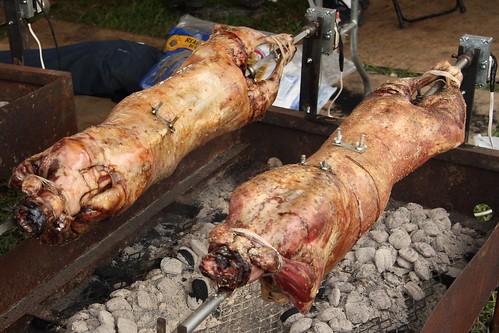
Once upon a time, when we were little, the strawberries tasted like strawberries. Unfortunately, they were only available for about two months during the early to middle summer. Then, a strange thing occurred: strawberries were suddenly available year-round, but they weren’t strawberries anymore. The flesh was dense and gummy where once it was meatier and juicier; and while the deep red color of a ripe strawberry usually indicated that it was at its sweetest, all of these new, strange strawberries were bright red while none of them tasted like it.
In my neighborhood Whole Foods, the strawberry season is celebrated with the abundance of ripe, perfect, “real” berries from nearby Watsonville, which has the ideal hot growing climate for this fruit. After about eight weeks, they are gone, but replaced by fake strawberries for the rest of the year. This is a poor, poor substitute, suitable not even for baking, as the average recipe is intended for a completely different little beast than that Driscoll berry that arrives at every grocery store nationwide in large, plastic containers.
So what are we to do? In an increasing amount of places, the focus is not whether the food is organic, but whether it is local. We know this, because it was on the cover of Time magazine about two years ago. If the berries are local, one can assume that they taste better, they cost less to transport, and since everything is increasingly organic, they were probably organic to begin with. Now, I live in San Francisco, which is the perfect Slow Food culinary storm for three major reasons: one, it is one of the so-called “bi-coastal” cities, which means it takes its culinary scene ridiculously seriously; two, really good food grows year-round within a 200 mile radius; and three, San Francisco is renowned for its self-righteously “correct” attitudes about such things as politics, social progressivism, health, and the environment.
Thus, the foodie life here is never-ending. With the coming of every July, people get hopping excited about the arrival of squash blossoms (generally stuffed with ricotta and basil, flour battered, and deep fried) as if it were an annual coming of Christ. And every winter, Bay Area restaurants line up to worship the Great White Truffle, sacrificing just obscene amounts of money to truffle dinners complete with appropriately paired wines from Piemonte. It’s the same as with clothes, when every September, Vogue reminds us that it’s coat and sweater time again and we all get our proverbial panties in a twist about pumpkin-colored Lanvin jackets and rush off to the Gap to buy the knockoff.
I suppose there are worse things to treat as a fad than seasonal food. God knows that traditionally, food fads are a boon for the food industry but generally end up with absurd situations. Right now, people in El Paso are able to order salmon to put on top of their Caesar salad, a combination I will never understand. Meanwhile, we are completely out of wild salmon and have to harvest it, inject it with all kinds of dye and hormones just to supply the demand we so stupidly created in the first place. In the case of San Francisco, when squash blossom season is over, it’s over. Time to move on and look forward to the actual squashes, to be puréed and put into filled pastas, to be made into soups, to be brushed with olive oil and roasted and salted. And then when those are done in the middle of winter, it’s put a fork in it already, because they’re done. When seasonal food is in fashion, everyone is sure to quit the season’s big food at the appropriate time. No sense looking like you’re behind the times. Just as you wouldn’t wear woolen tights in May, or keep your Christmas tree up in February. It’s just…not done.
This summer I went out to dinner with my sisters in Saint Louis. We ordered a wild mushroom pastry, which turned out to be this completely insane construction of masses of puff pastry, ten inches high, towering above a strewing of various mushrooms, sage, and entirely too much cream. The poor sauce was almost separated by the time it got to the table, and who could blame it? Those mushrooms were trying to get out. They were speaking to us.
“Look, damn you,” they said, while choking in their sea of dairy lipids, “We are criminis, we are oysters, we are shitakes. We are all mass-cultivated mushrooms, so it’s totally inappropriate that whoever created this menu decided to call us ‘wild’. We don’t have the delicate flavor of wild mushrooms, but if we did, it would be even more of a sin to put us in so much butter and cream. And this sage is some mass-distributed dried crap. The cows who made this milk are from the Midwest, the mushrooms were grown indoors in some Central Valley Californian mushroom multiplex, and the pastry flour is 100% SYSCO brand, milled God-Knows-Where from God-Knows-What. This is the most geographically and seasonally confused bullshit ever!”
Poor mushrooms, but they demonstrate some of the more senseless acts of eating. While San Franciscans are indeed completely silly for their food seasons, they do have a point. (Just don’t tell them that, please. Some of us Midwesterners have to live here.)
Like Dr. Seuss’ Lorax, I’d like to take a minute to speak for the mushrooms. If it would just occur to every American that, hey, it’s f-ing February, therefore the turkey sandwich simply cannot have tomatoes and butter lettuces on it, then perhaps we’d be doing something about those looming ozone holes and all-time high obesity levels. Until then, gorge on, fellow citizens, gorge on.
Meredith Jones
[Editor's note: Meredith is a St. Louisan in exile. She lives, works, writes, and plays in San Francisco. While she may be gone her spirit remains. Every fifth glint of sunlight reflecting off of the arch is just Meredith winking at us.]






































